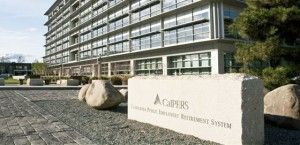CalPERS Needs Bailout Despite 21% Gain
by CalWatchdog Staff | July 19, 2011 3:09 pm
 [1]JULY 19, 2011
[1]JULY 19, 2011
By WAYNE LUSVARDI
CalPERS made an anemic 3.41 percent return over the last five years and only 0.98 percent over the last three years, falling far short of the 7.75 percent annual target return it needs to meet pension obligations.
But that is not what you probably have been reading in the mainstream media[2], which has reported an annual gain of 21 percent this past year up through June 2011, the highest returns for Cal-PERS in a decade.
CalPERS and CalSTRS pension funds are funded at only about 70 percent of liabilities, even after the large gain this past year. Jack Ehnes, chief executive officer of the CalSTRS, was quoted in the Asian Venture Capital Journal[3], not the U.S. mainstream media. He said, “Even given this past year’s impressive performance, CalSTRS would need more than a 20 percent return each year for the next four years to achieve full funding in 30 years, an impractical expectation.” Ehnes added that without legislation to raise contribution rates, the systems will “struggle.”
Were CalPERS and CalSTRS fund managers “geniuses” to get nearly a 21 percent annual return this past year? Apparently that was not the case.
S&P 500 Did Better
The public stock component of Cal-PERS’ investment portfolio had a 30 percent return, while the Standard & Poor’s 500 Index had about a 31 percent return over the same time interval. So in public stocks, at least, the CalPERS fund slightly under-performed a plain-vanilla index fund. Politicians couldn’t help make public union pensioners any windfall profits over investing in index funds invested in a 401(k).
An index fund is a passively managed fund designed to match the performance of the whole market or mix of funds. So whatever commissions CalPERS paid all its external fund managers to invest in public stocks apparently could have been saved just by passively investing in the S&P 500 Index.
Here’s the reported breakdown of profits in the financial statements of CalPERS and CalSTRS compared with a passive index mutual fund:
|
Percent Of Total Fund |
Cal-PERS Percent Return |
Cal-STRS Percent Return
|
PASSIVE INDEX FUND |
|
| Fund Balance as of June 30, 2011 |
N/A |
$237.5 billion |
$154.3 billion |
N/A |
| Gain 2010-2011 |
N/A |
$37 billion |
$29 billion |
N/A |
| Est. Underfunding |
N/A |
$101.8 billion |
$66.1 billion |
N/A |
| Private Equity Gains |
14
|
25.3
|
22.5
|
22.9 to 27.6 |
| Public Equity Gains |
49
|
30.2
|
31.9
|
31.0 |
| Fixed Income Gains (bonds) |
20
|
7
|
5.4 |
6.8
|
| Real Estate |
10
|
10.2
|
17.5
|
27.6 |
| Inflation investments: commodities, forest land, infrastructure, inflation adjusted bonds |
5
|
13.6
|
13.6
|
5.8 to 43.6
|
| Cash |
2 percent |
N/A |
N/A |
N/A |
| Source:http://www.bearseatbulls.com/2010-mutual-fund-performance-review/ http://www.avcj.com/avcj/news/2094886/calpers-calstrs-announce-annual-gains-excess?WT.rss_f=News&WT.rss_a=CalPERSpercent2C+CalSTRS+announce+annual+gains+in+excess+of+20 percent25[4] |
||||
Perhaps more importantly, the CalPERS and CalSTRS pension funds would require an additional infusion of about $167 billion to be fully funded, an unrealistic expectation. And even if $167 billion could miraculously appear, this would do nothing to protect the funds from the volatility of market cycles that occur about two to three years out of every 10 years, and bank panics or long-term structural corrections such as we are now experiencing.
Reporting annual percentage gains is one thing. But what does a 30 percent gain in CalPERS investments in public stocks mean? It appears to mean that the public has flooded their money into stocks, and out of bonds and real estate, after the bursting of the real estate bubble. When the bubble in stocks deflates, CalPERS can’t expect to sustain such returns.
After the Bust
The CalPERS fund had roughly $225 billion in September 2008. That was just before Lehman Brothers Holdings Inc. went bust, resulting in a bank panic that wiped out $6 trillion in the value of the stock market in only half a year. Zillow.com reported that real estate lost an additional $9 trillion[5] since the peak of the real estate market in 2007. This is 12 times the cost of the Iraq War, which cost $750.8 billion up to September 2010.
CalPERS’ 21 percent gain, though welcome, is not nearly enough to make up for its shortfall during the Great Recession.
- [Image]: http://www.calwatchdog.com/wp-content/uploads/2011/07/CalPERS-building.jpg
- mainstream media: http://www.sfgate.com/cgi-bin/article.cgi?f=/n/a/2011/07/18/state/n102940D49.DTL
- Asian Venture Capital Journal: http://www.avcj.com/avcj/news/2094886/calpers-calstrs-announce-announce-annual-gains-excess?WT.rss_f+News&WT.rss_a=CalPERS%252c+CalSTRS+anounce+annual+gains+in+excess+of+20%25
- http://www.avcj.com/avcj/news/2094886/calpers-calstrs-announce-annual-gains-excess?WT.rss_f=News&WT.rss_a=CalPERSpercent2C+CalSTRS+announce+annual+gains+in+excess+of+20 percent25: http://www.avcj.com/avcj/news/2094886/calpers-calstrs-announce-annual-gains-excess?WT.rss_f=News&WT.rss_a=CalPERS%252C+CalSTRS+announce+annual+gains+in+excess+of+20%25
- $9 trillion: http://www.thetruthaboutmortgage.com/9-trillion-in-home-equity-lost-since-real-estate-market-peak/
Source URL: https://calwatchdog.com/2011/07/19/calpers-needs-167-bil-bailout-despite-21-gain/